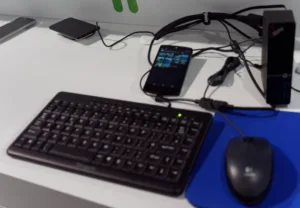DisplayLink showed graphics over USB using an Android phoneDisplayLink was in a positive mood. The company’s “graphics over USB” technology has been widely adopted by PC vendors who are able to use the technology to create universal docking systems for notebooks using just a single USB connection to the PC. The systems can support high resolution and the first dock that we looked at on the DisplayLink booth was from Dell. It was being shown running dual 1080 displays plus an UltraHD display. The firm told us that Lenovo would also have a dock for UltraHD in Q1, although both of these support only 30 Hz operation in UltraHD resolution. (I have been using 30Hz for some weeks, and find no problems with it – Man. Ed.)
Another demonstration was of a Toshiba dock running dual UltraHD displays over USB 3.0 and this was using a prototype chip to support P60 operation.
Just to push the point, DisplayLink was showing a Dell 5K display (in P30) and also a Surface 3 Pro which was driving an UltraHD display from its USB port.
Going round the booth, we also saw an Android phone that has a new driver from DisplayLink and can connect to a Lenovo PC dock to support dual 1080P displays, a keyboard and other peripherals. This is the first time we’ve seen DisplayLink on Android. Work is also being done to support Chrome as an operating system, but iOS remains too closed a system at the moment to allow driver development.
Display Daily Comment
We had an interesting conversation about USB alternate mode with DisplayLink.
This mode is used with a Type C USB connector to allow both USB and DisplayPort over a single connector. Although we have written positively about this (DisplayPort 1.3 – Could Become the Next Connection Standard), DisplayLink said that it had heard some negative comments from corporates that don’t like the fact that Type-C connectors may, or may not, include DisplayPort. That would mean that it wouldn’t be as universal as the DisplayLink solution.
Now, cynical readers might quote the famous phrase “They would say that, wouldn’t they”. In other words, if Type-C with DisplayPort became pervasive quickly, it might impact the sales of DisplayLink chips. However, there is some logic in the comment.
Another issue with Type-c is that if it is used to provide charging, it could cause confusion for consumers. For example, if a phone charger that uses Type-c to provide power is plugged into a notebook, it wouldn’t cause a problem, but it wouldn’t charge the notebook. That might cause user confusion.
On the other hand, over two or three years, it’s hard to imagine the PC vendors not supporting the alternate mode, so in the end, Type C will become pervasive, I think. (BR)

